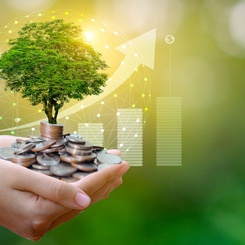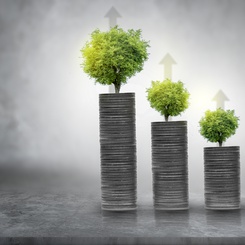With Francis Declerck
“Doing well while doing good” is the new mantra in finance. After years and years of piling up risky and no value-added investment practices, taking excessive risks, and being a burden for taxpayers, the finance sector seems to be back to basics, the efficient allocation of capital to promote the sustainable development of the economy.
A tectonic shift in society
Sustainability is shifting finance just as it is changing consumption. Millennials' consumption habits reveal that they care about sustainability, whether they are buying recycled sneakers or making financial investments. Studies like Schroders’ Global Investor Study 2020 ( September 2020) find that a vast majority of investors are not willing to compromise on their personal beliefs when putting their money to work, even if returns were higher.
The year 2020 was a record year for funds that use non-financial criteria such as environmental, social, and governance (ESG) criteria to generate financial return and a broader societal impact. 2020 was also a year where financial investors showed great interest in social and green bonds and more governments and corporations committed to investments with an environmental and social impact. In March 2021, Italy raised a record €8.5bn from green bonds. The bond was 10 times oversubscribed. During the second half of 2020, USD 178bn (€149 bn) worth of green bonds were added, almost double that of the first semester. Green bonds were issued in 24 currencies, and almost half were EUR denominated according to data from Climate Bond Initiative.The pandemic, along with climate change urgency and the movement for racial justice, have been and will likely continue to be catalysts for investors wanting to search for investments with environmental and social impact.
The European Green Deal is another engine on the transformation as it aims to make the EU's economy sustainable. The investment necessary for the transition to make the EU-climate neutral by 2050 is estimated at between €175 to €290 million in addition to yearly investments in the next decades. Regulators want to ensure that both public investments and private investments are dedicated to this goal. Therefore, the European Commission has published a set of measures enforcing the consideration of sustainability when making financial decisions.
Market imperfections to be solved and ESG criteria
Markets are great tools to allocate goods and financial securities, but they have shortcomings that lead to poor decisions. Markets do not correctly incorporate the cost of negative externalities, like alterations to common goods, air, water and land pollution, and the depletion of natural resources, etc. Furthermore, in 2005, focused on CO2 emissions that account for 75% of greenhouse gases, the EU set up the European Union Emission Trading Scheme (ETS), nicknamed the “carbon market” in order to go carbon-neutral by 2050. The ETS is the first international emissions trading system launched in the world, even though it reveals to be far from perfect. The EU is revising its policy to fight climate change in completing the ETS by launching a carbon border adjustment mechanism (CBAM) in the forthcoming months.
Fighting Greenwashing
As sustainable investing has become increasingly mainstream, the appeal of greenwashing grows. Unfortunately, statements in reports or websites saying that a firm cares about stakeholders or the environment does not represent a true commitment. Investors and stakeholders ask for a clarification of what is sustainable. The problem is worsened by the absence of clear, agreed-upon sustainable investment definitions.
Thus, besides given strong direction about the financing of the economy, regulation is promoting disclosure, transparency and certification of sustainable products. Both non-financial and financial companies have been encouraged to disclose non-financial information. But because there was still too much ambiguity about what is a sustainable investment, the EU taxonomy has given a step further and provides a classification of what constitutes a sustainable activity, becoming a strong guide for investors' decisions.
Is sustainable investing profitable?
The uttermost question is whether sustainable investing is profitable? Can we do well by doing good? As in other areas, the answer is not unequivocally a yes or a no. There are profitable and non-profitable sustainable investments. Like any other investment, sustainable investments have risks. There is nevertheless consensus that the acknowledgement and integration of environmental, social and governance factors can enhance returns and reduce risk, not only because of the growing materiality of non-financial risks but also because they can offer attractive returns. The green economy is en marche, and new investment opportunities are emerging.
Shaping Finance – the agenda
Recentering the attention of finance in the basics, the efficient allocation of capital is primordial. This time, the focus needs to be in creating value for all stakeholders and not only shareholders. The new approach in finance considers the impact of investing for society, in particular creating value for all stakeholders to make a resilient and inclusive economy. Efficiency and resiliency in the financial system is a source of positive externalities for society.
ESSEC chair « Shaping the future of finance »
The recently launched "Shaping the Future of Finance" Chair aims to attract talented students and train them as future responsible leaders to manage the income challenges. The chair partners are financial institutions that have a strong commitment and show a strong leadership in sustainable finance. They do not see sustainable investing as a trend but rather as an intrinsic part of their way of operating. The first partner is AXA IM Alts, a global leader in asset management.
The Chair aims at operating as a think tank to raise awareness on the importance of sustainability in finance, to identify the best practices in the financial industry to spread positive changes and to promote a long-term view of value creation









